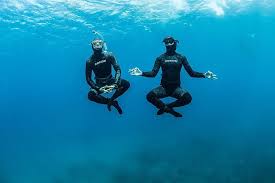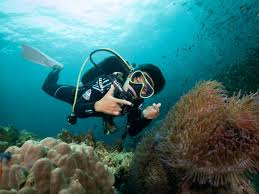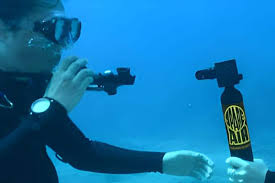Skin diving with a mini scuba tank offers a lightweight, portable alternative to traditional scuba gear, typically allowing 30–60 minutes of underwater exploration at depths of 10–20 feet (3–6 meters). These compact tanks, often holding 1–3 liters of compressed air, weigh under 10 lbs (4.5 kg), making them ideal for beginners or snorkelers seeking extended dive time. Key features include a simple regulator, adjustable buoyancy, and no bulky BCD, though they lack deep-dive capabilities. Always check local regulations and ensure proper training for safe use.
How Mini Tabs Work
Unlike full-sized scuba tanks (which typically hold 80-100 cubic feet of air), mini tanks range from 0.5 to 3 liters in capacity, providing 10-60 minutes of breathing time depending on depth and breathing rate. Most operate at 200-300 bar (2900-4350 psi) and weigh 2-10 lbs (0.9-4.5 kg), making them easy to carry for snorkelers or beginner divers. They’re not meant for deep dives—max depth is usually 20-30 ft (6-9 meters)—but they’re great for extending shallow-water exploration without bulky gear.
Air Supply & Breathing Time
A 1-liter tank at 200 bar holds roughly 200 liters of air when decompressed to surface pressure. An average diver breathes 15-20 liters per minute at the surface, but underwater, consumption increases with depth due to pressure. At 10 ft (3 meters), air lasts 20-30% less than at the surface. For example:
- 1L tank @ 200 bar → ~10-15 min at 10 ft
- 3L tank @ 300 bar → ~30-45 min at 10 ft
Pressure & Depth Limits
Mini tanks use the same compressed air as standard scuba (21% oxygen, 79% nitrogen), but their small size means they can’t support deep dives safely. Going beyond 30 ft (9 meters) drastically reduces air supply due to pressure changes. At 33 ft (10 meters), pressure doubles, so air consumption doubles too. A tank that lasts 30 minutes at the surface might only last 10 minutes at 33 ft.
Maintenance & Refills
Mini tanks require the same care as regular scuba tanks:
- Rinse after saltwater use to prevent corrosion.
- Store with 50-100 psi to avoid moisture buildup inside.
- Hydrostatic testing every 5 years (mandatory for safety).
Refilling costs 15 per tank at dive shops, depending on size. Unlike large tanks, they can’t be filled from a standard compressor—they need a high-pressure (300+ bar) fill station.
Who Should Use Them?
Mini tanks are best for:
- Snorkelers who want to dive briefly below the surface.
- Backup air for spearfishers or freedivers.
- Shallow reef explorers (not deep wreck divers).
They’re not a replacement for full scuba gear, but they’re a convenient middle ground between snorkeling and traditional diving. If you need more than 30 minutes underwater or plan to go deeper than 20 ft, a full scuba setup is safer.
Final Tips
- Practice breathing slowly to maximize air time.
- Check local laws—some places restrict mini tank use without certification.
- Never push limits—running out of air at depth is dangerous.
Safe Depth & Time Limits for Mini Scuba Tanks
Unlike full-sized scuba systems, which can support dives beyond 100 ft (30 meters), mini tanks are designed for shallow exploration only—typically 10-20 ft (3-6 meters). Their small air capacity (usually 1-3 liters) means you’ll have 10-30 minutes of breathing time, depending on depth and exertion. Going deeper drastically reduces your available air due to pressure changes. For example, at 33 ft (10 meters), your air consumption doubles compared to the surface. Understanding these limits is crucial for safe, enjoyable dives without unexpected air shortages.
How Depth Affects Air Consumption
This isn’t just about breathing harder—it’s physics. At 33 ft (10 meters), the surrounding water pressure is 2x surface pressure, meaning each breath pulls twice as much air from your tank. A mini tank that lasts 30 minutes at the surface might only give you 10-15 minutes at this depth. Here’s a quick breakdown:
| Depth (ft/meters) | Pressure Multiplier | Estimated Air Time (1L tank @ 200 bar) |
|---|---|---|
| Surface (0 ft / 0 m) | 1x | ~20-30 min |
| 10 ft / 3 m | 1.3x | ~15-20 min |
| 20 ft / 6 m | 1.6x | ~10-15 min |
| 30 ft / 9 m | 2x | ~7-12 min |
Key takeaway: If you’re planning to stay underwater longer, stay shallow. Every additional 10 ft (3 meters) cuts your air supply by 30-50%.
Why Mini Tanks Aren’t for Deep Diving
Beyond 20-30 ft (6-9 meters), mini tanks become inefficient and risky. Not only does air run out faster, but ascending from deeper depths requires safety stops to avoid decompression sickness (DCS). Mini tanks don’t carry enough air for proper ascent protocols. Additionally, their small regulators can freeze or malfunction under high exertion at depth. Most manufacturers explicitly state max depth limits of 20-30 ft—ignoring this risks air starvation at depth, a dangerous situation.
Breathing Rate & Air Efficiency
Your air supply depends heavily on how calmly you breathe. An average diver at rest uses 12-15 liters per minute (L/min), but stress or swimming can spike this to 25-30 L/min. Panicking at 20 ft (6 meters) could drain a 1L tank in under 5 minutes. To maximize your dive:
- Breathe slowly (aim for <15 L/min).
- Avoid rapid movements—swimming hard increases air use by 20-40%.
- Practice buoyancy control—flailing wastes air.
When to Surface
A good rule is to start ascending when half your air is gone. For a 1L tank, that means heading up after ~10 minutes at 20 ft (6 meters). Unlike full scuba systems, mini tanks don’t have reserve valves—you won’t get a warning before air runs out. Always monitor your time and depth closely.
Real-World Example: Spearfishing with a Mini Tank
A spearfisher using a 2L mini tank at 15 ft (4.5 meters) can expect ~20 minutes of dive time. If they chase fish aggressively (breathing 25 L/min), this drops to ~8 minutes. By staying relaxed and moving slowly, they can stretch it to 25+ minutes.
Final Safety Notes
- Never exceed 30 ft (9 meters)—mini tanks lack the air volume for safe deep diving.
- Always dive with a buddy—running out of air is less dangerous if someone can assist.
- Check tank pressure before diving—a 200 bar fill is standard; anything below 150 bar significantly shortens dive time.

Choosing the Right Gear for Mini Scuba Diving
The market offers tanks ranging from 0.5L to 3L, with prices spanning 600 depending on materials (aluminum vs. carbon fiber) and included accessories. A typical 1L aluminum tank weighs 4.5 lbs (2 kg) and provides 10-15 minutes at 20 ft (6 m), while a 3L carbon fiber model at 6.6 lbs (3 kg) extends this to 30-45 minutes - but costs 2-3x more. Key considerations include your average dive depth, duration needs, and budget.
Tank Capacity vs. Dive Time Tradeoffs
For casual snorkelers who just want brief subsurface exploration, a 0.5-1L tank (providing 5-15 minutes at 15 ft/4.5 m) offers the best portability at 2-5 lbs (0.9-2.3 kg). However, spearfishers or reef photographers needing 20+ minutes should consider 2-3L tanks, accepting the 7-10 lb (3.2-4.5 kg) penalty. Carbon fiber models like the XS Scuba 3L shave 30% weight off aluminum equivalents but cost 250-300 for aluminum.
Regulator Performance Matters
Entry-level models often have higher breathing resistance (1.4-2.1 inches H2O) compared to premium units (0.8-1.2 inches H2O), making inhalation more strenuous after 15+ minutes. The ScubaPro AIR series demonstrates this well - their 150 alternatives degrade to 2.5+ inches as tank pressure drops below 100 bar. For frequent divers, investing in a balanced diaphragm regulator improves comfort despite the $100-200 premium.
Buoyancy Considerations
Mini tanks create 2-5 lbs (0.9-2.3 kg) of negative buoyancy when full, requiring compensation. A 3mm wetsuit provides about 4 lbs (1.8 kg) of lift at 20 ft (6 m), while a 5mm adds 7 lbs (3.2 kg). This becomes critical when using larger tanks - a 3L tank with a 5mm suit may actually make you 2-3 lbs (0.9-1.4 kg) positively buoyant at depth. Many divers add 2-4 lbs (0.9-1.8 kg) of weight to their belt when using 2L+ tanks to maintain neutral buoyancy throughout the dive.
Maintenance Costs Add Up
While the initial purchase stings, long-term costs vary significantly:
- •Aluminum tanks require hydrostatic testing every 5 years ($40-60 per test)
- •Carbon fiber tanks need testing every 3 years ($60-80)
- •Regulator servicing runs $80-120 annually with heavy use
- •Tank valve O-ring replacements cost $5-15 each (needed every 50-100 fills)
Over 5 years, a 500+ with maintenance, while a 900. However, the carbon fiber option saves 15,000+ calories in carrying weight over that period - worth considering for frequent divers.
Accessory Essentials
Several add-ons dramatically improve functionality:
- 1.Pressure gauges ($40-80) - Crucial for monitoring remaining air
- 2.Neoprene tank wraps ($20-40) - Prevent overheating in sunlight
- 3.Quick-release mounts ($30-60) - Allow fast tank switching
- 4.Mouthpiece disinfectant kits ($15) - Essential for hygiene
Budget $100-200 for these extras regardless of your main gear choice. The pressure gauge alone can prevent 80% of emergency air situations by revealing consumption rates in real-time.
Where to Compromise
For beginners, the sweet spot is:
- •1.5-2L aluminum tank ($250-350)
- •Mid-range regulator ($200-250)
- •Basic accessories (550-700
This provides 15-25 minutes at 15-20 ft (4.5-6 m) with reasonable maintenance costs. Advanced divers should consider carbon fiber 2.5-3L systems (200 complete kits - their regulators often fail within 6-12 months and tanks may not meet DOT/CE standards.
Basic Diving Techniques for Mini Scuba Tanks
With limited air supply (10-30 minutes depending on tank size and depth) and no buoyancy compensator (BCD), you need to maximize efficiency in every movement. The average diver burns 300-400 calories per hour underwater, but poor technique can spike air consumption by 40-60%, cutting dive time short. Mastering these fundamentals helps you stay submerged longer while reducing fatigue and air waste.
Breathing Control Is Everything
At rest, most divers use 12-15 liters per minute (L/min), but stress or exertion can push this to 25-30 L/min—halving your dive time. The key is diaphragmatic breathing: slow, deep inhales (3-4 seconds) followed by complete exhales (4-5 seconds). This maintains an optimal 10-12 L/min rate, extending a 1L tank’s air supply from 10 to 15+ minutes at 15 ft (4.5 m). Practice on land first: lying down, place one hand on your chest and the other on your stomach. Only the stomach hand should rise when breathing correctly.
Streamlining Your Movements
Water is 800x denser than air, meaning every unnecessary motion wastes energy. Keep your body horizontal, arms close to your sides, and fin kicks small and controlled. Wide, powerful kicks increase drag by 20-30%, burning extra air. Instead, use short, flutter kicks from the hips (not knees) at a steady 40-50 kicks per minute. If you need to turn, roll your entire body rather than twisting at the waist—this preserves momentum and cuts energy use by 15-20%.
Buoyancy Without a BCD
Mini scuba tanks don’t have buoyancy compensators, so you must manage lift naturally. A full 1L aluminum tank weighs 4.5 lbs (2 kg) but loses 0.5 lbs (0.23 kg) of weight as you consume air. To stay neutral:
- At the surface: Inhale deeply to float, exhale fully to sink.
- At depth: Wear 2-4 lbs (0.9-1.8 kg) of lead weight (adjusted for wetsuit thickness).
- During ascent: Exhale gradually to avoid rapid buoyancy changes.
A 3mm wetsuit provides 4 lbs (1.8 kg) of lift at 20 ft (6 m), while a 5mm suit adds 7 lbs (3.2 kg). Test your weighting in shallow water before diving—ideal weighting lets you hover motionless at 10 ft (3 m) with half-empty lungs.
Air Conservation Strategies
Since mini tanks lack reserve valves, plan your dive backward:
- Allocate 20% of air for ascent (e.g., 50 bar in a 200-bar tank).
- Spend 60% exploring (e.g., 120 bar).
- Keep 20% as emergency reserve (e.g., 30 bar).
If you’re at 15 ft (4.5 m) with a 1L tank, ascend when you hit 50 bar—this leaves enough air for a slow, 1-minute ascent plus 30 seconds at the surface. Never push limits; running out at 15 ft forces an emergency swim-up, risking lung overexpansion.
Emergency Procedures
Despite precautions, problems happen. If you run low on air:
- Signal your buddy immediately (don’t wait until empty).
- Drop weights if necessary (but only if positively buoyant).
- Ascend no faster than 30 ft/min (9 m/min)—faster risks decompression issues.
For regulator freeflows (air suddenly blasting out):
- Cover the mouthpiece to reduce air loss.
- Switch to backup air if available.
- Ascend slowly while exhaling continuously.
Practice in Confined Water First
Before open-water diving, rehearse in a pool or shallow bay:
- Breathing drills: Try staying submerged for 5 minutes on 50 bar to simulate emergencies.
- Weight checks: Adjust lead until you can hover effortlessly at 10 ft (3 m).
- Buddy communication: Test hand signals ("Low on air", "Ascend now") at 15+ ft (4.5+ m) where verbal cues fail.
Maintenance & Care Tips for Mini Scuba Tanks
A poorly maintained tank can lose 5-10% of its air capacity annually due to internal corrosion, while neglected regulators may develop 2-3x higher breathing resistance after just 50 dives. Proper care extends equipment lifespan by 300-500%: aluminum tanks typically last 15-20 years with maintenance versus 5-7 years without, while carbon fiber tanks can reach 20-25 years when cared for correctly. The best part? Most maintenance takes under 10 minutes per dive and costs less than $100 annually—far cheaper than replacing failed gear mid-season.
Post-Dive Rinsing Protocol
Saltwater is 50x more corrosive than freshwater, attacking metal components at 0.1-0.5mm per year if left untreated. After every saltwater dive, fully submerge your tank and regulator in fresh water for 15-20 minutes, then rinse again under a low-pressure hose (high-pressure jets can force salt into O-ring seals). Pay special attention to the tank valve threads—these corrode 3-5x faster than the tank body. For regulators, press the purge button while rinsing to flush salt from internal chambers. In tropical climates, daily rinsing is mandatory—humidity above 70% accelerates corrosion by 200-300% compared to dry climates.
Storage Conditions Matter
Never store tanks fully empty—residual moisture inside combines with oxygen to form rust at 0.05-0.2mm/year. Instead, keep 50-100 psi (3.5-7 bar) of air inside as a moisture barrier. Store vertically in a cool (50-80°F/10-27°C), dry (<50% humidity) place—garages and cars often exceed 100°F (38°C), which degrades tank composites 2-3x faster. For regulators, hang them upside-down to prevent water pooling in the first stage. Silica gel packs (changed every 3 months) in storage bags reduce internal humidity by 60-80%.
O-Ring Maintenance Schedule
The 12-20 O-rings in your system are failure points—each costs 5 but causes $100+ repairs if they leak. Replace:
- Tank valve O-rings every 50 fills
- Regulator mouthpiece O-rings every 30 dives
- HP seat O-rings every 2 years
Apply 100% silicone grease (not petroleum-based) during replacements—this extends O-ring life by 200-400%. Before each dive, perform a soap bubble test: mix 1 teaspoon dish soap with 1 cup water, apply to connections, and watch for bubbles indicating leaks.
Hydrostatic Testing Intervals
All tanks require pressure testing to confirm structural integrity:
- Aluminum tanks: Every 5 years ($40-60 per test)
- Carbon fiber tanks: Every 3 years ($60-80)
- Visual inspections: Annually ($15-25)
Testing involves filling to 5/3 of working pressure (e.g., 333 bar for a 200 bar tank) to detect micro-fractures. Tanks failing test show >10% permanent expansion—retire them immediately. Keep records—many dive shops refuse fills without current hydro stamps.
Regulator Servicing
A $250 regulator lasts 10-15 years with proper servicing versus 3-5 years without. Schedule:
- Annual light service ($60-80): Replace filters, lubricate moving parts
- Biannual deep service ($120-150): Replace all wear components
- After 300 dives: Full overhaul (replace 80% of internal parts)
Key indicators you need service:
- Breathing resistance >1.5 inches H2O
- Intermittent freeflows
- Air tastes metallic (indicates internal corrosion)
Cost-Benefit Analysis
Investing $150/year in maintenance saves:
- $300-500 in premature tank replacement
- $200-400 in regulator rebuilds
- $1000+ in emergency repairs from failures
For occasional divers, renting tanks may cost less ($15-25 per dive) than maintaining your own. But for 50+ dives/year, ownership with proper care is 40-60% cheaper long-term.





اترك تعليقًا
تخضع جميع التعليقات للإشراف قبل نشرها.
This site is protected by hCaptcha and the hCaptcha Privacy Policy and Terms of Service apply.